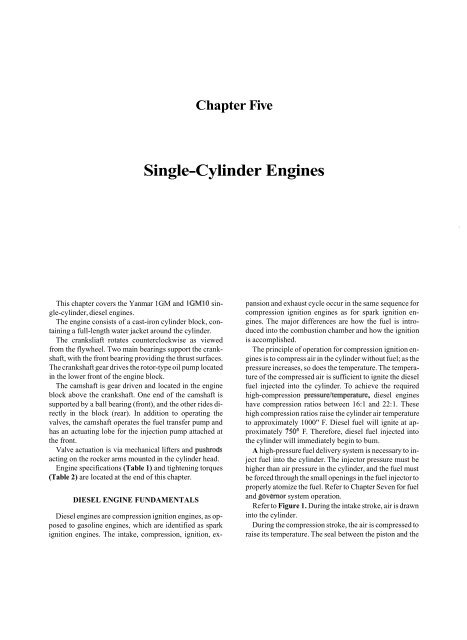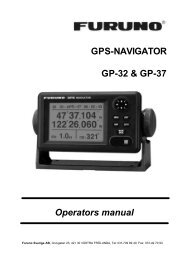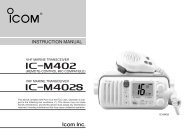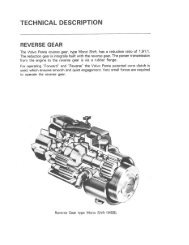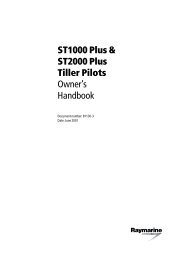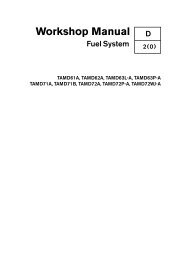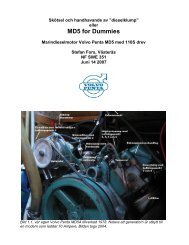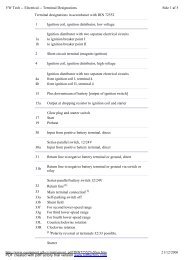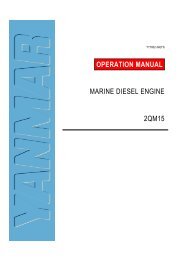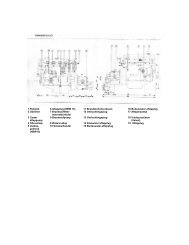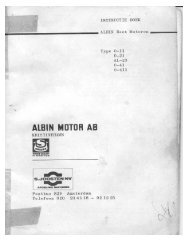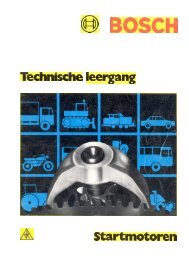You also want an ePaper? Increase the reach of your titles
YUMPU automatically turns print PDFs into web optimized ePapers that Google loves.
Chapter Five<br />
Single-Cylinder Engines<br />
This chapter covers the Yanmar 1 GM and lGM 10 single-cylinder,<br />
diesel engines.<br />
The engine consists of a cast-iron cylinder block, containing<br />
a full-length water jacket around the cylinder.<br />
The cranksliaft rotates counterclockwise as viewed<br />
from the flywheel. Two main bearings support the crankshaft,<br />
with the front bearing providing the thrust surfaces.<br />
The crankshaft gear drives the rotor-type oil pump located<br />
in the lower front of the engine block.<br />
The camshaft is gear driven and located in the engine<br />
block above the crankshaft. One end of the camshaft is<br />
supported by a ball bearing (front), and the other rides directly<br />
in the block (rear). In addition to operating the<br />
valves, the camshaft operates the fuel transfer pump and<br />
has an actuating lobe for the injection pump attached at<br />
the front.<br />
Valve actuation is via mechanical lifters and pushrods<br />
acting on the rocker arms mounted in the cylinder head.<br />
Engine specifications (Table 1) and tightening torques<br />
(Table 2) are located at the end of this chapter.<br />
DIESEL ENGINE FUNDAMENTALS<br />
Diesel engines are compression ignition engines, as opposed<br />
to gasoline engines, which are identified as spark<br />
ignition engines. The intake, compression, ignition, ex-<br />
pansion and exhaust cycle occur in the same sequence for<br />
compression ignition engines as for spark ignition engines.<br />
The major differences are how the fuel is introduced<br />
into the combustion chamber and how the ignition<br />
is accomplished.<br />
The principle of operation for compression ignition engines<br />
is to compress air in the cylinder without fuel; as the<br />
pressure increases, so does the temperature. The temperature<br />
of the compressed air is sufficient to ignite the diesel<br />
fuel injected into the cylinder. To achieve the required<br />
high-compression pressure/temperature, diesel engines<br />
have compression ratios between 16: 1 and 22: 1. These<br />
high compression ratios raise the cylinder air temperature<br />
to approximately 1000" F. Diesel fuel will ignite at approximately<br />
750" F. Therefore, diesel fuel injected into<br />
the cylinder will immediately begin to bum.<br />
A high-pressure fuel delivery system is necessary to inject<br />
fuel into the cylinder. The injector pressure must be<br />
higher than air pressure in the cylinder, and the fuel must<br />
be forced through the small openings in the fuel injector to<br />
properly atomize the fuel. Refer to Chapter Seven for fuel<br />
and governor system operation.<br />
Refer to Figure 1. During the intake stroke, air is drawn<br />
into the cylinder.<br />
During the compression stroke, the air is compressed to<br />
raise its temperature. The seal between the piston and the


